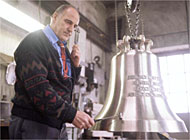Swiss church bells: more than a wake-up call

Hans Jürg Gnehm, a Thurgauer campanologist, estimates that there are at least 12,000 bells in Switzerland-and that doesn't include the ones hanging around the cows' necks.
From downtown Zürich to the Engadin, bells are part of Swiss life: tolling the noon hour, calling churchgoers to Sunday services, marking the end of the workweek, and more.
Switzerland’s biggest bell, Susanne, weighs 10½ tons and has hung in Bern’s cathedral since 1611. In the days before the job was mechanized, it took eight men to ring her.
Down the street from Susanne in Bern’s Nydegg church is Agathe; she has around a tenth of Susanne’s weight but is 128 years older. For centuries Agathe served the city as a fire alarm, even surviving a fire in 1568 that started in the belltower itself and brought her crashing to the ground.
Historically, church bells like Susanne and Agathe were familiar to everyone. They warned of fire, flood or war and summoned villagers for meetings, markets, and harvests. Thanks to their supposed magical powers, they were even rung to dispel storms.
In the Ticino, it was traditional at christenings to ring a “suná da ligría” or peal of joy just as the baby was sprinkled with holy water, and bells throughout Switzerland are still rung for weddings, christenings, funerals, and Christian holidays. In addition, most towns have what are called civic peals, which mark the hours and celebrate patriotic festivals.
Last bell foundry
The oldest Swiss bell that still rings is hanging in Fribourg’s cathedral and was cast in Aarau in 1367 by a certain Walter Reber. Astonishingly, Reber’s business still survives today as H. Rüetschi AG, Switzerland’s last surviving church-bell foundry.
The Aarau firm casts and mounts an average of 25 church bells a year and does repairs and maintenance on many more. Currently, however, company manager René Spielmann’s biggest interest is carillons.
“We’ve just finished a new 36-bell carillon in the Église Sainte-Croix in Carouge; the inaugural concert is on September 7. Five days later another of our carillons will be starting up in Sisikon, just above the William Tell Chapel in Uri,” says Spielmann.
The carillon, or Glockenspiel, popular in Belgium, the Netherlands, and northern France, is not common in Switzerland. Spielmann would like to change that, and so would Werner Walter, president of the Swiss Guild of Carillonneurs and Campanologists (or bell experts).
“A carillon has a special keyboard that can’t simply be played like a piano’s. We’re delighted with the instrument in Carouge, which will be one of the best in the country and should attract some very good carillonneurs,” says Walter.
Dial-a-tune
He is disappointed, however, that Switzerland’s other new carillon is automated. “We wish that the Chocosuisse Association, which sponsored the Sisikon instrument, had spoken to us,” Walter says. “Maybe we could have talked them out of funding what is essentially just a big music box.”
That big music box has some interesting features, however, as Stefan Muri, of Jakob Muri AG, is glad to point out. The company, started by his father and continued by him and his brother Ivo, is responsible for the carillon’s playing system.
“When a tourist ship on the Lake of Lucerne nears the carillon, the captain can choose a melody and start the music using his cell phone,” explains Muri. “Eventually, school classes will be able to compose tunes and send them via the Net. Later, when a particular class comes to visit, they’ll be able to hear their own pieces on the carillon.”
Although genuine Swiss carillons are rare, sets of chimes with fewer than eight bells are common in churches in both the Valais and the Ticino. These chimes were traditionally played by local farmers, who tied the bell-clappers to ropes that they manipulated with their hands and feet to create rhythmic peals.
Unfortunately, not everyone in Switzerland enjoys the sound of church-bells, especially on Sunday mornings. “Our first Sunday-morning peal is at 8:30, and it’s six minutes long,” says the sacristan at Bern’s Nydegg church, Walter Schleusser. “You’d be amazed how many people complain.”
Obviously, Mr. Schleusser is not a late sleeper.
by Kim Hays

In compliance with the JTI standards
More: SWI swissinfo.ch certified by the Journalism Trust Initiative
You can find an overview of ongoing debates with our journalists here. Please join us!
If you want to start a conversation about a topic raised in this article or want to report factual errors, email us at english@swissinfo.ch.